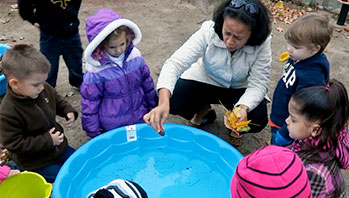- digging tools
- bucket for each group
- baking pans or cardboard box lids (for exploring/comparing soil)
- camera
- magnifying lenses
- pail
- string
- trowels
- chart paper
- crayons
- dirt
- environment
- grow
- plant
- root
- soil
- underground
- worm
MA Standards
English Language Arts/Language/L.PK.MA.6: Use words and phrases acquired through conversations, listening to books read aloud, activities, and play.
MA Draft STE Standards:
Life Sciences/Ecosystems; Biological Evolution/LS2/4.C: Investigate local environments and infer/imagine how some living things might meet basic needs. [Structure and Function; Cause and Effect]
Life Sciences/Ecosystems; Biological Evolution/LS2/4.D: Determine the variety of living things in a local area and characteristics of the places where they were found.
Life Sciences/Ecosystems; Biological Evolution/LS2/4.E: Predict where they might find a familiar plant or animal and explain why they think so based on experience and knowledge of the organism. [Patterns]
Head Start Outcomes
Logic and Reasoning/Reasoning and Problem Solving: Classifies, compares, and contrasts objects, events, and experiences.
Science Knowledge/Scientific Skills and Method: Observes and discusses common properties, differences, and comparisons among objects.
Science Knowledge/Scientific Skills and Method: Collects, describes, and records information through discussions, drawings, maps, and charts.
Science Knowledge/Conceptual Knowledge of Natural and Physical Worlds: Observes, describes, and discusses living things and natural processes.
PreK Learning Guidelines:
English Language Arts/Language 2: Participate actively in discussions, listen to the ideas of others, and ask and answer relevant questions.
Science and Technology/Inquiry Skills 4: Record observations and share ideas through simple forms of representation such as drawings.
Science and Technology/Living Things and Their Environment 15: Use their senses of sight, hearing, touch, smell, and taste to explore their environment using sensory vocabulary.
Science and Technology/Living Things and Their Environment 17: Observe and describe how natural habitats provide for the basic needs of plants and animals with respect to shelter, food, water, air, and light.
Explore Together (outdoors): Plant Environment

© Commonwealth of Massachusetts, Department of Early Education and Care. All rights reserved.
STEM Key Concepts: Plants get their needs met from the environment (their habitat); Some plant parts are below the ground and some above; Earthworms are animals that live in the soil, underground
ELA Focus Skills: Listening and Speaking, Vocabulary
Educator Prep: Before the activity, go outside and find an area around flourishing plants that children can safely dig in. Mark an area for children to explore by marking off a small circle (about two feet across) with the string. If possible, set up areas where there are different types of soil.
Safety Tips:
- Be aware of and check for poison ivy and poison sumac before gathering children in a designated area.
- Remind children to wash their hands before and after the activity.
- Remind children not to eat ANY plants or touch any plants without asking an adult.
- Take children’s allergies into account before going outside.
Tell children that today they are going outside to continue exploring living things and where they live and grow. Explain that they will look at different types of soil (moist soil, dry soil, rocky soil) and observe the different kinds of living things they find in or on that soil. Review what children observed in the previous outdoor exploration by asking questions such as,
- Do you think you will find the same things in each environment (moist soil, dry soil, rocky soil)?
- In what environment do you think you will find some of the same things that are in our worm environment? What things do you think will be similar?
- Do you think you will find worms in the dry soil? Why do you think that?
Take children outside and assign small groups to an area you marked off with string. Provide materials for children to dig with, such as digging tools, a bucket for collecting nonliving materials, and magnifying lenses for children to look closely at things they find. Take photographs or videos as children explore.
Reflect and Share
Talk about what children discovered today about the different environment they explored. Share the photos and activity materials so children can refer to them as they speak. Ask,
- What did you find in the circle next to the building?
- What did you observe in the circle next to the tree?
- What did you observe in the circle next to the parking lot?
Have children return to the groups they explored with and ask them to work in groups to draw on large pieces of paper what they found in their circle. When children have recorded their observations, use the drawings as you ask questions such as,
- Why do you think you didn’t see any worms in the <rocky soil>?
- What did you notice about the soil where you found the worms?
- What did you notice about the kinds of plants you found growing in the area?
Social Emotional Tip: Help children build their ability to formulate and express their own thoughts, ideas, and opinions by giving them opportunities to make predictions.
Educator Tip: Be aware of children who show a dislike for worms. Do not force them to touch the worms, but encourage them to take part in other parts of the activity.
Adaptation: For children with tactile sensitivities, you may want to have large spoons on hand so those children can join in the activity comfortably.
